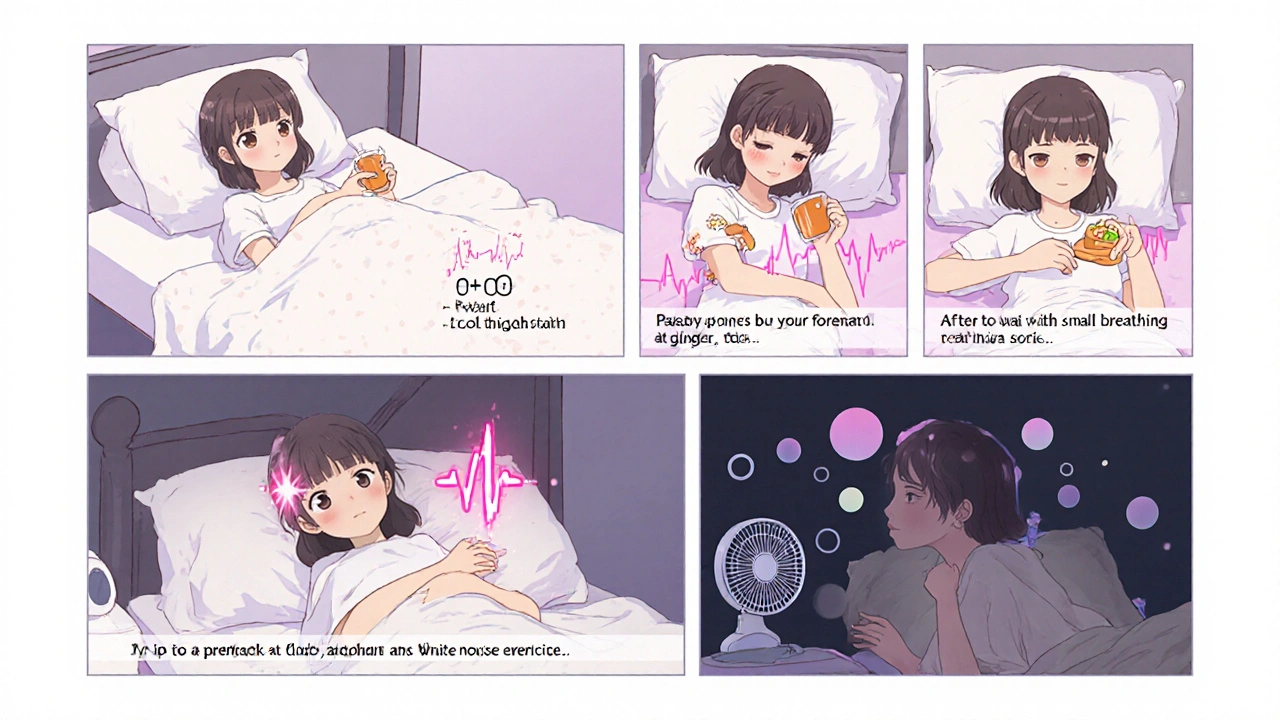Sleep Position Calculator
Find Your Best Sleep Position
Based on your pregnancy stage and symptoms, we'll recommend the most effective sleep position to reduce nighttime nausea.
Recommended Sleep Position
Your best sleep position will appear here after calculation.
Quick Takeaways
- Hormonal spikes in early pregnancy can trigger nausea at night as well as in the morning.
- Adjusting sleep position, using an elevated pillow, and keeping fluids nearby can cut night‑time vomiting.
- Gentle foods, ginger, and light acupressure often reduce nausea without medication.
- When nausea is severe or you’re losing weight, call your provider - there are safe prescription options.
- Consistent bedtime rituals and a cool, dark room improve overall sleep quality.
If you’re battling morning sickness sleep issues, you’re not alone. Many expectant mothers find that the same queasy feeling that hijacks their sunrise also creeps into the night, turning a simple bedtime into a guessing game of where the next wave will strike.
When you hear Morning Sickness is the nausea and vomiting many people experience during the first trimester of pregnancy, the mind jumps to the dreaded early‑morning trips to the bathroom. But what most don’t realize is that the same hormonal roller‑coaster can keep you tossing at night too.
Likewise, Sleep is the natural, reversible state of reduced consciousness that restores body and mind becomes a scarce resource when morning sickness intrudes. Below is a practical roadmap that blends medical insight with night‑time hacks, so you can finally get a decent night’s rest.
What Is Morning Sickness and Why It Affects Sleep
Morning sickness is a misnomer; the nausea can strike any hour, especially after the first few weeks when hormones like human chorionic gonadotropin (hCG) and estrogen skyrocket. These hormones not only upset the stomach lining but also influence the brain’s vestibular system, which controls balance and spatial orientation. The result? A feeling of queasiness that wors’t when you lie flat.
During pregnancy, Pregnancy is the condition of carrying one or more embryos or fetuses within the uterus triggers a cascade of physiological changes: increased blood volume, slower gastric emptying, and heightened sense of smell. All of these make the stomach a less forgiving place at night when digestion naturally slows.
Another culprit is Insomnia is difficulty falling or staying asleep, often linked to stress or medical conditions. The anxiety of not knowing when the next wave of nausea will hit can keep the mind buzzing, turning the bedroom into a stress zone.
How Nighttime Symptoms Disrupt Rest
Two main mechanisms interrupt sleep:
- Physical discomfort. Lying flat increases pressure on the stomach, aggravating nausea. The womb also expands, which can press on the diaphragm and make breathing feel shallow.
- Physiological triggers. Hormone spikes raise the brain’s chemoreceptor trigger zone, making even a faint smell enough to start a wave of vomiting.
Both lead to frequent awakenings, a drop in Sleep hygiene is practices that improve the quality and duration of sleep scores, and a vicious cycle where tiredness fuels more nausea.

Practical Sleep Strategies for Expecting Moms
Below are evidence‑backed tactics that address the physical and hormonal roots of nighttime nausea.
1. Optimize Your Sleep Position
The side‑lying position, especially on the left side, takes pressure off the inferior vena cava-a large vein that runs alongside the spine. This improves blood return to the heart and reduces the feeling of queasiness.
| Position | Pros | Cons |
|---|---|---|
| Left side | Improves circulation, reduces reflux, eases nausea | May cause shoulder strain if not supported |
| Right side | Comfortable for many, still reduces pressure on back | Less optimal for blood flow compared to left |
| Back‑lying | Easy to get into | Increases pressure on the uterus, worsens nausea and breathing |
Support the chosen side with a Elevated pillow is a wedge‑shaped pillow that keeps the upper body inclined or a body pillow to keep the spine neutral.
2. Keep Light Snacks at Hand
Low‑glycemic crackers, plain yogurt, or a half‑banana can settle the stomach faster than a full dinner. Aim for 5‑10 grams of carbohydrate every two to three hours.
3. Hydration with a Twist
Sip water throughout the night, but add a splash of lemon or a few mint leaves for a mild, soothing flavor. Cold, clear fluids are less likely to trigger reflux.
4. Ginger and Acupressure
Ginger tea, candied ginger, or ginger capsules (< 1 gram per dose) have been shown in multiple randomized trials to reduce nausea severity by up to 30%.
For acupressure, press the P6 point is the inner forearm spot three finger-widths above the wrist crease with a wristband or thumb for 5 minutes before bed. Many women report fewer night‑time bouts.
5. Control Light and Noise
A dark, cool room (around 65°F or 18°C) signals melatonin production. Use blackout curtains and a white‑noise machine if street sounds are distracting.
6. Mindful Breathing and Relaxation
Simple breathing exercises-inhale for 4 seconds, hold for 4, exhale for 6-can calm the vagus nerve, which modulates nausea. Pair this with a short guided meditation or progressive muscle relaxation.
Diet and Lifestyle Tweaks That Calm Nausea
Beyond bedtime, the foods you eat all day influence night‑time comfort.
- High‑protein breakfasts. Eggs, cottage cheese, or a protein shake keep blood sugar stable.
- Small, frequent meals. Instead of three big meals, aim for 5‑6 mini‑meals.
- Avoid strong odors. Garlic, fried foods, and spicy sauces often trigger nausea.
- Limit caffeine. A cup of tea is fine, but caffeine can uplift stomach acid.
Consider a daily Prenatal vitamin is a supplement containing folic acid, iron, and other nutrients essential for fetal development that includes B‑complex vitamins; B‑6 in particular has been linked to reduced nausea.

When to Seek Medical Help
Most morning sickness resolves by week 12‑14, but if any of these red flags appear, contact a health professional:
- Vomiting more than twice a day and inability to keep fluids down.
- Weight loss of more than 5% of pre‑pregnancy weight.
- Signs of dehydration: dark urine, dizziness, rapid heartbeat.
- Persistent fever or severe abdominal pain.
Doctors can prescribe safe anti‑emetics such as doxylamine‑pyridoxine (Diclegis) or ondansetron when needed. These medications do not harm the baby and can dramatically improve sleep quality.
Quick Checklist for Better Night’s Rest
- Sleep on your left side with a supportive body pillow.
- Keep a light snack and water within arm’s reach.
- Drink ginger tea or chew a small piece of ginger before bed.
- Press the P6 acupressure point for five minutes.
- Maintain a cool, dark bedroom and use white noise.
- Do a 5‑minute breathing routine right before lights out.
Frequently Asked Questions
Can I take over‑the‑counter nausea meds at night?
Yes, many doctors recommend doxylamine (found in sleep aids) combined with vitamin B‑6. Always check with your provider first, especially if you have other health conditions.
Is it safe to use a fan while pregnant?
A fan can improve air circulation and keep the room cool, which helps melatonin production. Just make sure the airflow isn’t directly on your belly.
How often should I change positions during the night?
If you’re comfortable, stay in the same side‑lying spot for a full sleep cycle. If you wake up feeling queasy, gently shift to the opposite side and use your pillow for support.
Does melatonin help pregnant women sleep?
Low‑dose melatonin (0.5mg) is considered safe for short‑term use, but discuss with your OB‑GYN before starting any supplement.
What’s the best bedtime routine for a calm stomach?
A light, bland snack, a cup of ginger tea, a quick P6 press, and 5 minutes of breathing exercises. Then dim the lights, set the room to ~65°F, and slip into your left‑side position.



Comments
Intrauterine hemodynamics shift; side‑lying mitigates supine hypotensive syndrome.
Wow!!! This guide is a lifesaver!!!! I can’t believe how many tiny tricks you missed earlier!!!
Thanks for the practical tips. The left‑side pillow is a game changer.
Hey there! I totally get how exhausting night‑time nausea can be, but remember you’re literally creating a new life, which is the ultimate marathon. Try the left‑side position and keep a mini‑snack like a soda‑cracker by the bed – it can stop a wave before it even starts. Also, a few minutes of deep breathing before you hit the pillow can reset your vagus nerve and make the whole process smoother. Keep experimenting, and celebrate every small win – even if it’s just falling asleep for 30 minutes without an upset stomach. You’ve got this!
Honestly, most of these “tips” read like they were copied from a generic pregnancy brochure written by someone who never slept through a night of nausea. The real issue is that many women ignore the physiological basis – the hormone‑induced chemoreceptor trigger and the mechanical pressure on the diaphragm. If you’re not adjusting your sleep environment to accommodate the increased intra‑abdominal pressure, you’re setting yourself up for a nightmare. Also, don’t be fooled by the “light snack” advice; you need complex carbs, not just crackers, to maintain stable blood glucose. And that whole “keep ginger nearby” spiel? It’s useful, but it won’t replace proper anti‑emetic therapy when symptoms are severe. So, while the article is a decent starting point, it glosses over the necessity of seeking professional guidance earlier rather than later.
Stop trying to sound like a medical textbook! You’re making this sound more intimidating than it needs to be. Simple changes like a wedge pillow and a sip of lemon water are enough for most, without the drama of “professional guidance” every five minutes.
Precision matters: the body’s homeostatic mechanisms are well‑documented, and over‑medicalizing trivial nausea does more harm than good.
Wow, this article is sooo helpful!!! 😂 But did you know the pharma companies are secretly pushing ginger supplements to keep us buying their pricey anti‑emetics? 🤔 Stay woke!
OMG, this piece is literally a culinary masterpiece for the pregnant mind. I mean, the way they weave the P6 acupressure technique with a dash of ginger is pure gastronomic poetry. But like, seriously, why are they not mentioning the ancient Ayurvedic practices that have been around since, I dunno, forever? Sooo much room for improvement, lol.
When considering the intersection of nocturnal nausea and sleep architecture, it is useful to adopt a systems‑level perspective that accounts for hormonal fluctuations, gastrointestinal motility, and circadian rhythm alignment. First, the surge in human chorionic gonadotropin and estrogen during the first trimester exerts a measurable influence on the chemoreceptor trigger zone, thus heightening susceptibility to emesis at any hour. Second, the supine position increases intra‑abdominal pressure, which can impede diaphragmatic excursion and exacerbate reflux, leading to a feedback loop of discomfort and sleep fragmentation. Third, the act of ingesting low‑glycemic carbohydrates before bedtime stabilizes plasma glucose, reducing the autonomic arousal that often precipitates a nausea episode. Fourth, temperature regulation plays a non‑trivial role; a cooler ambient environment of approximately 65 °F promotes melatonin synthesis while also mitigating vasomotor symptoms. Fifth, the P6 acupressure point has been substantiated in multiple meta‑analyses as a non‑pharmacological intervention that modulates vagal tone. Sixth, ginger’s bioactive compounds, such as gingerol, act on the gastrointestinal tract to accelerate gastric emptying, thereby alleviating the sensation of fullness that can trigger vomiting. Seventh, mindfulness‑based breathing exercises engage the parasympathetic nervous system, reducing cortisol levels that otherwise interfere with sleep onset. Eighth, consistent bedtime rituals serve as conditioned cues for the suprachiasmatic nucleus, reinforcing the sleep‑wake cycle despite hormonal turbulence. Ninth, the strategic use of a wedge pillow creates a physiologic angle of approximately 30 degrees, effectively lowering the risk of reflux and pressure on the uterus. Tenth, staying hydrated with sipped water prevents dehydration‑induced tachycardia, which can otherwise heighten the perception of nausea. Eleventh, regular prenatal vitamin intake, particularly vitamin B‑6, supports neurotransmitter synthesis that mitigates emetic pathways. Twelfth, it is imperative to monitor for red‑flag symptoms such as weight loss exceeding five percent, persistent vomiting, or signs of dehydration, and to seek obstetric consultation promptly. Lastly, while these behavioral interventions are valuable, they are not a substitute for evidence‑based pharmacotherapy when indicated, and shared decision‑making with a healthcare provider remains the gold standard. By integrating these multimodal strategies, pregnant individuals can create a more resilient sleep environment and reduce the disruptive impact of morning sickness on nocturnal rest.
Great suggestions, Rohit! I’ve tried the breathing routine and the wedge pillow, and they really helped me get a solid few hours of sleep. Keep sharing these practical hacks.